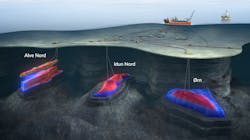Norway’s government sanctions multiple Aker BP hub projects
Offshore staff
LYSAKER, Norway – Aker BP has gained approvals for nine plans for development and operation (PDO) and one plan for installation and operation, all submitted toward the end of 2022.
Norway’s Ministry of Petroleum and Energy has sanctioned proposals relating to the Skarv Satellite Projects (SSP); Symra and Solveig Phase 2 in the Utsira High region of the North Sea; and Yggdrasil and Valhall PWP-Fenris in the northern and southern Norwegian North Sea.
Aker BP estimates total net recoverable resources from the projects at more than 700 MMboe, with an average breakeven of $35-40/bbl.
The programs will help grow the company’s production across the shelf from about 400,000 bbl/d last year to 525,000 bbl/d in 2025.
SSP encompasses the gas and condensate discoveries Alve Nord, Idun Nord and Ørn. All will be developed via a four-slot subsea template and two wells, tied back to the Skarv FPSO. Combined recoverable resources are close to 120 MMboe, mainly gas, with an overall cost approaching NOK17 billion ($1.58 billion).
Production should begin in summer 2027, with incremental CO2 emissions of 4.5 kg/boe.
The Symra Field will be a tie-in to the Ivar Aasen production platform and should start producing early in 2027.
Solveig Phase 2, an extension of the PDO for the first development phase of Solveig started by former operator Lundin, will be connected via existing infrastructure at Solveig to the Edvard Grieg platform. Production should begin in first-quarter 2026.
The two developments will target a combined 93 MMboe, with drilling getting underway in summer 2025. The combined costs should be NOK16 billion ($1.48 billion).
Yggdrasil, comprising the Hugin, Fulla and Munin license groups, is situated between the Alvheim and Oseberg field centers.
“We see considerable potential in the area and recently announced a significant oil discovery on Øst Frigg Beta/Epsilon,” said Yggdrasil senior vice president Lars Høier.
The Øst Frigg Beta/Epsilon discovery, estimated currently at 40 MMboe to 90 MMboe, has increased overall resources in the Yggdrasil area to more than 700 MMbbl.
Aker BP and its alliance partners have built flexibility into the development concept to acoomodate tie-ins of future discoveries and fields. The entire Yggdrasil area will be remotely operated from an onshore integrated operations center and control room in Stavanger, with power from shore contributing to emissions of less than 1 kg/bbl of CO2.
Detailed engineering is advancing, all major contracts have been signed and the company has begun placing thousands of purchase orders to suppliers nationally and internationally. It expects construction to proceed as planned during the fall.
Finally, Valhall PWP-Fenris is ready now for construction startup. The coordinated development will extend the lifetime of the Valhall field center, according to project director Rannveig Storebø.
A new centrally located production and wellhead platform (PWP) will be bridge-linked to the Valhall platform complex, and an unmanned installation on Fenris (ex-King Lear), 50 km to the south, will be connected to PWP through subsea pipelines.
New reserves targeted are estimated at 230 MMboe, and the project will ensure a lifetime extension beyond 2028 for Valhall and continued production of 137 MMboe of existing Valhall reserves.
The development will draw on the existing power from shore system with CO2 emissions of less than 1 kg/bbl.
“We are now also establishing Valhall as a gas hub,” a spokesman said.” Production from Fenris will substantially increase gas export from Valhall to Europe and will more than double gas processing capacity.”
06.28.2023
